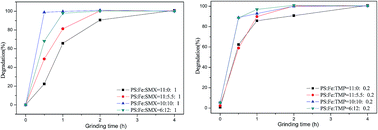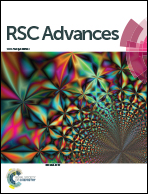Fe0-activated persulfate-assisted mechanochemical destruction of expired compound sulfamethoxazole tablets
Abstract
Sulfamethoxazole (SMX) and trimethoprim (TMP) in compound sulfamethoxazole tablets (CSTs) are a typical class of pharmaceuticals, and they belong to the pseudo-POPs due to their persistence and environmental hazard. For the first time, this study investigated the persulfate-assisted mechanochemical destruction of the actual drug, the expired CSTs, to discuss the degradation effect and the degradation mechanism of SMX and TMP. The primary results indicated that NaOH is not suitable to activate persulfate for the treatment of tablets containing starch and that Fe0 performs better than CaO to assist persulfate in the mineralization of organic chemicals. Furthermore, the efficacy of Fe0-activated persulfate-assisted mechanochemical (Fe-PS-MC) degradation of SMX and TMP in the CSTs was investigated. Under the optimum reaction conditions with mass ratios of PS : Fe : SMX = 10 : 10 : 1 and PS : Fe : TMP = 10 : 10 : 0.2, the degradation was completed within 0.5 h, while the mineralization was completed within 2 h. The ESR spectroscopy confirmed the generation of ˙OH and SO4−˙, providing solid evidence that the MC treatment with PS activated by Fe0 as an additive reagent can efficiently degrade SMX and TMP in the expired CSTs. Finally, the mechanisms of SMX and TMP degradation by the Fe-PS-MC treatment system were set forth, and initiation pathways were proposed.


 Please wait while we load your content...
Please wait while we load your content...